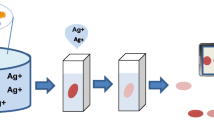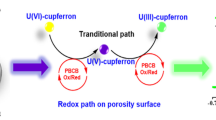Abstract
Flexible silver substrates were made by in situ reduction of silver nanoparticles in bacterial cellulose membranes using the unique advantage of dopamine. Subsequently, we modified the substrate with 4-mercaptophenol (4-MP), a molecule capable of specifically recognizing ClO–, and its corresponding SERS signal changes with the concentration of hypochlorite, thus allowing the quantitative detection of ClO– content. The method showed a negative linear correlation (R2 = 0.9567) with the SERS intensity at 1077 cm−1 over the concentration range 0.5–100 µM, and the detection limit was 0.15 µM. The RSD of the SERS intensity at 1077 cm−1 under five batches was 4.2%, which proved the good reproducibility of P-BCM-Ag NP-MP. Finally, the P-BCM-Ag NPs were used for the detection of hypochlorite in cell contents, artificial urine, and clinical serum samples, utilizing spike experiments in all three environments. The recoveries were in the range 90–110% indicating the accuracy of the method for the detection of hypochlorite and validating the promising application of this assay for practical detection in intricate biological samples.
Graphical Abstract











Similar content being viewed by others
Data availability
Data will be made available on request.
References
Hammerschmidt S, Vogel T, Jockel S, Gessner C, Seyfarth H-J, Gillissen A, Wirtz H (2007) Protein kinase c inhibition attenuates hypochlorite-induced acute lung injury. Respir Med 101:1205–1211. https://doi.org/10.1016/j.rmed.2006.11.003
Özyürek M, Bekdeşer B, Güçlü K, Apak R (2012) Resorcinol as a spectrofluorometric probe for the hypochlorous acid scavenging activity assay of biological samples. Anal Chem 84:9529–9536. https://doi.org/10.1021/ac302369p
An Z, Zhao Z, Zhao L, Yue Q, Li K, Zhao B, Miao J, Su L (2020) The novel HOCl fluorescent probe can induced a549 apoptosis by inhibiting chlorination activity of MPO. Bioorg Med Chem Lett 30:127394. https://doi.org/10.1016/j.bmcl.2020.127394
Xu Q, Lee K-A, Lee S, Lee KM, Lee W-J, Yoon J (2013) A highly specific fluorescent probe for hypochlorous acid and its application in imaging microbe-induced HOCl production. J Am Chem Soc 135:9944–9949. https://doi.org/10.1021/ja404649m
Kim PA, Choe D, So H, Park S, Suh B, Jeong S, Kim K-T, Kim C, Harrison RG (2021) A selective fluorescence sensor for hypochlorite used for the detection of hypochlorite in zebrafish. Spectrochim Acta Part A 261:120059. https://doi.org/10.1016/j.saa.2021.120059
Chen B, Fu H, Lv Y, Li X, Han Y (2018) An oxidative cyclization reaction based fluorescent “turn-on” probe for highly selective and rapid detection of hypochlorous acid. Tetrahedron Lett 59:1116–1120. https://doi.org/10.1016/j.tetlet.2018.02.018
Hoebe RA, Van Oven CH, Gadella TWJ, Dhonukshe PB, Van Noorden CJF, Manders EMM (2007) Controlled light-exposure microscopy reduces photobleaching and phototoxicity in fluorescence live-cell imaging. Nat Biotechnol 25:249–253. https://doi.org/10.1038/nbt1278
Peteu SF, Bose T, Bayachou M (2013) Polymerized hemin as an electrocatalytic platform for peroxynitrite’s oxidation and detection. Anal Chim Acta 780:81–88. https://doi.org/10.1016/j.aca.2013.03.057
Zhang L-J, Zhao X, Yang D, Jia Z-Z, Han X, Sun L-Q, Yu L-L, Liu J-T, He X-D, Miao J-Y, Zhao B-X (2018) A new water-soluble and mitochondria-targeted fluorescence probe for ratiometric detection of hypochlorous acid in living cells. Sens Actuators B 276:8–12. https://doi.org/10.1016/j.snb.2018.08.071
Zhang W, Guo C, Liu L, Qin J, Yang C (2011) Naked-eye visible and fluorometric dual-signaling chemodosimeter for hypochlorous acid based on water-soluble p-methoxyphenol derivative. Org Biomol Chem 9:5560–5563. https://doi.org/10.1039/C1OB05550J
Hao J, Meng X (2017) Recent advances in SERS detection of perchlorate. Front Chem Sci Eng 11:448–464. https://doi.org/10.1007/s11705-017-1611-9
Lin Z, He L (2019) Recent advance in SERS techniques for food safety and quality analysis: a brief review. Curr Opin Food Sci 28:82–87. https://doi.org/10.1016/j.cofs.2019.10.001
Chen Y, An Q, Teng K, Liu C, Sun F, Li G (2023) Application of SERS in in-vitro biomedical detection. Chem – Asian J 18:e202201194. https://doi.org/10.1002/asia.202201194
Ogundare SA, van Zyl WE (2019) A review of cellulose-based substrates for sers: fundamentals, design principles, applications. Cellulose 26:6489–6528. https://doi.org/10.1007/s10570-019-02580-0
Zhang Q, Xu G, Guo N, Wang T, Song P, Xia L (2021) In-situ synthesis of methyl cellulose film decorated with silver nanoparticles as a flexible surface-enhanced raman substrate for the rapid detection of pesticide residues in fruits and vegetables. Materials. https://doi.org/10.3390/ma14195750
Jin J, Guo Z, Fan D, Zhao B (2023) Spotting the driving forces for SERS of two-dimensional nanomaterials. Mater Horiz. https://doi.org/10.1039/D2MH01241C
Deshmukh AR, Dikshit PK, Kim BS (2022) Green in situ immobilization of gold and silver nanoparticles on bacterial nanocellulose film using punica granatum peels extract and their application as reusable catalysts. Int J Biol Macromol 205:169–177. https://doi.org/10.1016/j.ijbiomac.2022.02.064
Wu C-N, Fuh S-C, Lin S-P, Lin Y-Y, Chen H-Y, Liu J-M, Cheng K-C (2018) Tempo-oxidized bacterial cellulose pellicle with silver nanoparticles for wound dressing. Biomacromol 19:544–554. https://doi.org/10.1021/acs.biomac.7b01660
Cao S, Yang Y, Zhang S, Liu K, Chen J (2021) Multifunctional dopamine modification of green antibacterial hemostatic sponge. Mater Sci Eng C 127:112227. https://doi.org/10.1016/j.msec.2021.112227
Liao J, He S, Guo S, Luan P, Mo L, Li J (2019) Antibacterial performance of a mussel-inspired polydopamine-treated Ag/graphene nanocomposite material. Materials. https://doi.org/10.3390/ma12203360
Zhang Z, Si T, Liu J, Zhou G (2019) In-situ grown silver nanoparticles on nonwoven fabrics based on mussel-inspired polydopamine for highly sensitive serscarbaryl pesticides detection. Nanomaterials. https://doi.org/10.3390/nano9030384
Ass BAP, Frollini E, Heinze T (2004) Studies on the homogeneous acetylation of cellulose in the novel solvent dimethyl sulfoxide/tetrabutylammonium fluoride trihydrate. Macromol Biosci 4:1008–1013. https://doi.org/10.1002/mabi.200400088
Li D, Jiang D, Xie J (2015) Controllable synthesis of fluorapatite microcrystals decorated with silver nanoparticles and their optical properties. RSC Adv 5:12392–12396. https://doi.org/10.1039/C4RA13072C
Xu LQ, Chen JC, Wang R, Neoh K-G, Kang E-T, Fu GD (2013) A poly(vinylidene fluoride)-graft-poly(dopamine acrylamide) copolymer for surface functionalizable membranes. RSC Adv 3:25204–25214. https://doi.org/10.1039/C3RA42782J
Xie Y, Yue L, Zheng Y, Zhao L, Liang C, He W, Liu Z, Sun Y, Yang Y (2019) The antibacterial stability of poly(dopamine) in-situ reduction and chelation nano-Ag based on bacterial cellulose network template. Appl Surf Sci 491:383–394. https://doi.org/10.1016/j.apsusc.2019.06.096
Ben-Jaber S, Peveler WJ, Quesada-Cabrera R, Sol CWO, Papakonstantinou I, Parkin IP (2017) Sensitive and specific detection of explosives in solution and vapour by surface-enhanced raman spectroscopy on silver nanocubes. Nanoscale 9:16459–16466. https://doi.org/10.1039/C7NR05057G
Wang W, Zhang L, Li L, Tian Y (2016) A single nanoprobe for ratiometric imaging and biosensing of hypochlorite and glutathione in live cells using surface-enhanced Raman scattering. Anal Chem 88:9518–9523. https://doi.org/10.1021/acs.analchem.6b02081
Chen J, Wang J, Geng Y, Yue J, Shi W, Liang C, Xu W, Xu S (2021) Single-cell oxidative stress events revealed by a renewable SERS nanotip. ACS Sens 6:1663–1670. https://doi.org/10.1021/acssensors.1c00395
Zhang X, Xie X, Zhang L, Yao K, Huang Y (2022) Optoplasmonic MOFs film for SERS detection. Spectrochim Acta Part A 278:121362. https://doi.org/10.1016/j.saa.2022.121362
Chen C, Wang J, Lu D, You R, She Q, Chen J, Feng S, Lu Y (2022) Early detection of lung cancer via biointerference-free, target microrna-triggered core–satellite nanocomposites. Nanoscale 14:8103–8111. https://doi.org/10.1039/D1NR07670A
Wonjung L, Youn H, Bae J, Kim D-H (2021) Solid-phase colorimetric sensor for hypochlorite. Analyst 146:2301–2306. https://doi.org/10.1039/D0AN02448A
Xie L, Zheng R, Hu H, Li L (2022) Determination of hypochlorite and bisulfite in water by bifunctional colorimetric sensor based on octupolar conjugated merocyanine dyes. Microchem J 172:106931. https://doi.org/10.1016/j.microc.2021.106931
Fu X, Wu J, Xu H, Wan P, Fu H, Mei Q (2021) Luminescence nanoprobe in the near-infrared-ii window for ultrasensitive detection of hypochlorite. Anal Chem 93:15696–15702. https://doi.org/10.1021/acs.analchem.1c03582
Erdemir S, Malkondu S, Kocyigit O, Alici O (2022) Antharacene-modified isophorone derivative with NIR-emission for hypochlorite detection by the oxidative decomposition reaction and its applications. Measurement 193:111007. https://doi.org/10.1016/j.measurement.2022.111007
Guo D, Wu S, Xu X, Niu X, Li X, Li Z, Pan J (2019) A novel label-free hypochlorite amperometric sensor based on target-induced oxidation of benzeneboronic acid pinacol ester. Chem Eng J 373:1–7. https://doi.org/10.1016/j.cej.2019.05.027
Sun J, Liu R, Tang J, Zhang Z, Zhou X, Liu J (2015) Controlled assembly of gold nanostructures on a solid substrate via imidazole directed hydrogen bonding for high performance surface enhance Raman scattering sensing of hypochlorous acid. ACS Appl Mater Interfaces 7:16730–16737. https://doi.org/10.1021/acsami.5b04449
Acknowledgements
The authors are grateful for the support of the Fujian Provincial Department of Science and Technology guiding Project (No. 2020Y0019); Industry-University Cooperation Project of Fujian Provincial Department of Science and Technology (2020N5006); Achievement Transformation Project of Fuzhou Science and Technology Bureau (2020-GX-20); Fushimei Agricultural and rural maker space (Minkexing (2019) No.2); and Program for Innovative Research Team in Science and Technology in Fujian Province University.
Author information
Authors and Affiliations
Contributions
Ruiyun You: supervision, writing—review and editing; Qian Huang: collected experimental samples and perform the experiments, formal analysis, analyzed the experimental data, writing—original draft, and data curation; Ziyi Lin: analyzed the experimental data. Wenxi Wang: formal analysis; Jiansen Lie: formal analysis; Jingbo Chen: methodology and validation; Guifeng Zhang: supervision and validation; Yudong Lu: supervision, conceptualization, and funding acquisition.
Corresponding authors
Ethics declarations
Competing interests
The authors declare no competing interests.
Additional information
Publisher's Note
Springer Nature remains neutral with regard to jurisdictional claims in published maps and institutional affiliations.
Highlights
• In situ reduction of silver nanoparticles on bacterial cellulose membranes using dopamine.
• Prepared flexible silver substrates with good SERS enhancement.
• The limit of detection of the hypochlorite is 0.15 µM.
Supplementary Information
Below is the link to the electronic supplementary material.
Rights and permissions
Springer Nature or its licensor (e.g. a society or other partner) holds exclusive rights to this article under a publishing agreement with the author(s) or other rightsholder(s); author self-archiving of the accepted manuscript version of this article is solely governed by the terms of such publishing agreement and applicable law.
About this article
Cite this article
You, R., Huang, Q., Lin, Z. et al. Preparation of SERS base membrane with cellulose compound dopamine and determination of hypochlorite. Microchim Acta 190, 447 (2023). https://doi.org/10.1007/s00604-023-06006-4
Received:
Accepted:
Published:
DOI: https://doi.org/10.1007/s00604-023-06006-4




